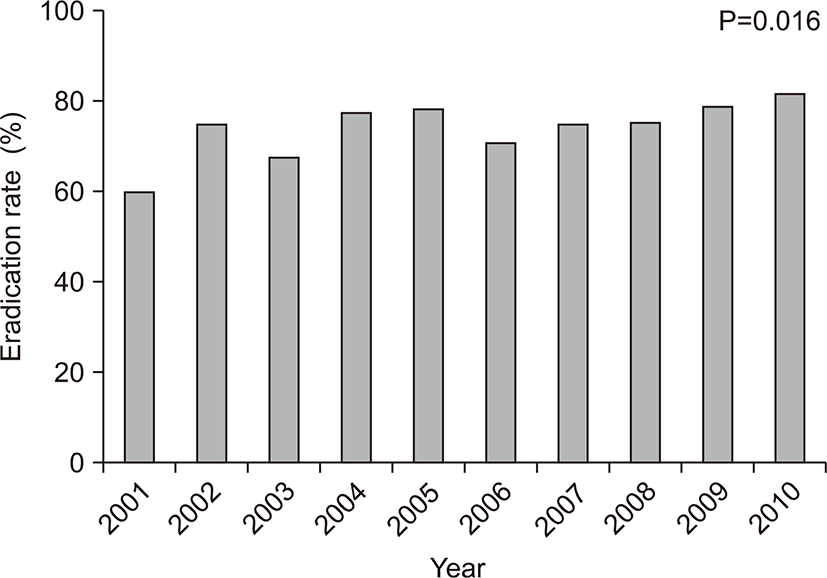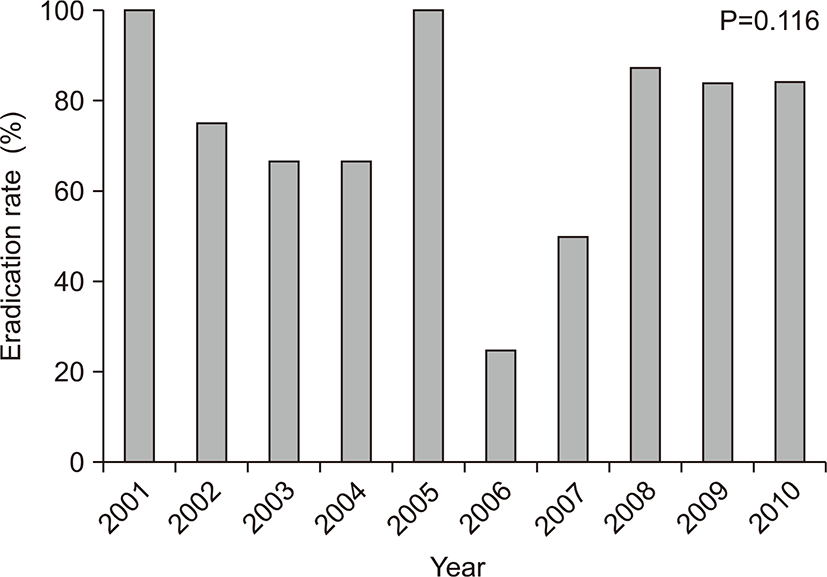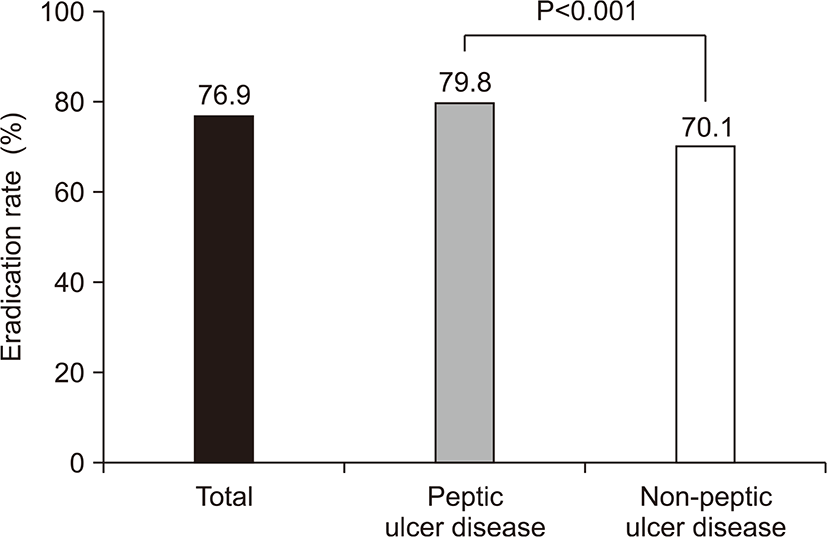서 론
만성 위염, 소화성 궤양, 위선암, 위에서 발생하는 변연부 B세포 림프종(MALT type) 등의 위험 인자로 알려진 Helicobacter pylori는 삼제 병합 요법을 표준 치료로 하고 있다. 국내에서 분리된 H. pylori는 metronidazole에 대한 내성률이 매우 높아 표준 삼제 요법의 항생제에는 amoxicillin과 clarithromycin을 포함하며 여기에 위산 분비 억제제인 프로톤 펌프 억제제(proton pump inhibitor, PPI) 로 구성된다[1]. 이 조합은 80~90% 이상의 치료율을 보이며 복용이 간편하고 부작용이 적어 환자의 순응도가 높은 편이다[2].
그러나 항생제 내성으로 인해 최근 1차 치료의 제균율이 감소 추세라는 보고가 있다[3]. 따라서 이번 연구는 서울 단일기관을 대상으로 연도별 1차 및 2차 치료의 제균율 변화를 조사하고, 소화성 궤양 및 비궤양성 위장 질환(위염, 위암, 변연부 B세포 림프종 등) 제균 적응증에 따른 제균율을 비교하였다.
방 법
2001년부터 2010년까지 이화여자대학교 부속 목동병원에 내원하여 소화성 궤양 또는 비궤양성 위장 질환(만성 위염, 위암, 변연부 B세포 림프종) 및 H. pylori 감염을 진단 받고 H. pylori 제균 치료를 받은 2,717명의 환자를 대상으로 하였다. 이 환자들 중 상부위장관 내시경 시행하였으며 H. pylori 감염 양성 판정을 받고 제균 치료 6~8주 후 결과를 확인한 1,471명을 대상으로 H. pylori 검사의 적응증, 내시경 소견, 제균 치료 결과를 조사하였다. 이 중 표준 삼제요법의 1차 제균에 성공한 1,133명을 제외한 338명 중 174명을 대상으로 표준 사제요법으로 2차 제균 치료를 하였으며, 1차, 2차 제균율과 내시경 소견별 제균율을 비교하였다.
1차 치료로서 삼제요법은 PPI 제제인 esomeprazole (Hassle Lakemedel Ab, Molndal, Sweden), lansoprazole (Takeda Pharmaceutical Co., Osaka, Japan), omeprazole (Chong Kun Dang Pharmaceutical Co., Seoul, Korea), pantoprazole (Nycomed, Zurich, Switzerland), rabeprazole (Janssen Korea, Seoul, Korea) 중 한 가지 약제를 사용하였으며 clarithromycin (Abbott Laboratories, Abbott Park, IL, USA) 500 mg 1일 1회, amoxicillin (Chong Kun Dang Pharmaceutical Co.) 1.0 g 1일 2회를 총 7일간 투여하였다. 1차 치료 후의 제균 판정은 투약이 종료된 이후 6~8주 후에 조직검사나 요소호기검사를 하여 제균 치료 성공여부를 결정하였다.
1차 제균에 실패한 환자들에 대하여 bismuth 포함 사제요법으로 2차 치료를 시행하였으며 PPI 중 한 가지 약제(esomeprazole, lansoprazole, omeprazole, pantoprazole, rabeprazole)를 1일 2회, tripotassium dicitrate bismuthate (Green Cross Co., Yongin, Korea) 300 mg과 tetracycline (Chong Kun Dang Pharmaceutical Co.) 500 mg을 1일 4회, metronidazole (CJ Cheiljedang Pharma Co., Seoul, Korea) 500 mg을 1일 3회로 7일에서 14일간 투여하였다. H. pylori 제균 여부는 치료가 끝나고 6~8주 지난 후에 조직검사나 요소호기검사로 판정하였다.
결 과
Amoxicillin과 clarithromycin의 동시 처방을 조건으로 검색된 2,717명의 환자 중 포함 기준을 만족 시키는 전체 대상 환자는 1,466명이었으며 이 중 남성은 879명(60.0%), 여성은 587명(40.0%)이었다. 평균 나이는 47.8±11.9세였으며, 내시경 소견은 위궤양 278명(19.0%), 십이지장궤양 692명(47.2%), 위궤양과 십이지장궤양이 같이 있는 경우 116명(7.9%), 위암 8명(0.5%), 변연부 B세포 림프종 2명(0.1%), 위염 336명(22.9%), 기타 등의 소견이 있었으며 십이지장궤양이 가장 많았다(Table 1).
전체 환자에서 10년간의 1차 제균율은 평균 77% (per protocol analysis)으로 나타났고, 남자와 여자에서 제균율은 각각 79.9%와 72.7%로 남자가 통계적으로 유의하게 더 높았다(P=0.001).
연도별 제균율은 2001년 60%, 2002년 75%, 2003년 67.7%, 2004년 77.8%, 2005년 78.5%, 2006년 70.9%, 2007년 75%, 2008년 75.3%, 2009년 78.9%, 2010년 81.9%였다. H. pylori 제균율은 최근 5년간 증가하고 있는 추세(chi square test for trend; χ2=6.231, P=0.013, per protocol analysis)였으며, 전체 10년간을 분석하여도 감소 추세는 관찰되지 않았다(Fig. 1).
338명(전체 환자의 23%)의 1차 제균 실패 환자 중 51.6% (174명, 전체 대상의 11.9%)가 2차 제균 치료를 시행 받았고, 평균 2차 제균율은 81.6%였다(2001년 100%, 2002년 75%, 2003년 67%, 2004년 67.5%, 2005년 100%, 2006년 24%, 2007년 50%, 2008년 88%, 2009년 83%, 2010년 83%, P=0.116) (Fig. 2).
전체 제균율은 76.9%였으며, 소화성 궤양과 비궤양성 병변의 제균율을 비교하였을 때 소화성 궤양환자 970명 중 774명이 제균 치료에 성공하였으며 비궤양성 병변 환자 461명 중 323명이 제균 치료에 성공하여 소화성 궤양 환자의 제균율이 통계적으로 유의하게 높았다(79.8% vs. 70.1%; P<0.001) (Fig. 3).
고 찰
H. pylori는 소화성 궤양, 만성 위염의 원인이며 위선암, 변연부 B세포 림프종의 발생과 연관되어 있어[1], 이에 대한 적극적인 치료가 필요하다. 2009년도 The American Journal of Gastroenterology에 실린 논문[3]에 따르면 1차 제균 치료 성공률은 540명 중 380명(intention-to-treat [ITT] 분석, 70.3%; per protocol [PP] 분석, 76%), 2차 제균 치료 성공률은 120명 중 83명(ITT, 69.1%; PP, 73.45%), 3차 제균 치료 성공률은 30명 중 21명(ITT, 70%; PP, 70%)로 낮았으며, 과거 국내외 삼제요법의 제균 치료 성공률은 80%~90% 정도로 연구마다 편차가 있으나 전반적으로 감소하는 추세이다[4-11]. 제균에 실패하는 원인으로는 환자의 순응도 부족, 항생제 내성, CYP2C19의 다형성에 의한 개인간 PPI의 효과 차이, 고밀도의 H. pylori 균집락의 형성, 숙주 면역 반응의 이상 등 여러 가지 원인이 있으며 이 중 환자의 순응도가 치료 성적에 큰 영향을 미친다는 연구가 있다[2]. 한 보고에 의하면 일차 제균 요법에 60% 이상의 복약 순응도를 보이는 경우 90% 이상의 치료 성공률을 보여주었으며, 60% 미만의 복약 순응도를 보이는 경우 약 70% 내외의 성공률을 보인다고 하여 치료의 순응도가 중요 요소임을 증명하였다[12]. 순응도 이외에 최근 제균율이 감소하는 원인으로는 항생제 내성을 꼽을 수 있다[13,14]. H. pylori 제균 치료법으로 적합하기 위해서는 per protocol analysis에서 90% 이상의 치료 성공률, intention to treat analysis에서 80% 이상의 치료 성공률을 보이고 심한 부작용은 5% 이하에 해당해야 하며 가급적 단기간인 1주일 간의 치료기간이 바람직하다고 권장되고 있기 때문에[2] 제균율이 앞으로 더 떨어지게 된다면 표준 치료의 방법을 재고해야 한다. 따라서 본 연구는 연도에 따른 제균율 변화와 내시경 병변에 따른 제균율 차이를 서울 서부 지역 단일 기관의 환자를 대상으로 후향적 연구를 하였으며 10년간의 H. pylori 1차 제균율과 2차 제균율의 변화를 살펴 보았다.
앞서 언급하였듯이 제균율이 감소하는 추세로 국내에서는 75.3~87.2% 로 감소하는 경향을 보였다. 최근 2010년 발표된 국내 연구에서는 2001년부터 2009년까지의 전체환자 H.pylori 제균율은 77.0% 였으나 연도별 제균율 감소는 없었다(P=0.974) [15]. 이번 연구 결과 10년간 1차 제균율은 감소하지 않았으며 최근 5년간에는 제균율은 통계적으로 유의하게 증가 추세를 보여 주었다. 그러나 전체적으로 80% 미만의 제균율을 보여 위의 연구 결과와 유사한 결과를 보였다. 병변에 따라서는 소화성 궤양이 79.8%, 비궤양성 병변이 70.1%로, 통계적으로 유의하게 궤양성 병변의 제균율이 더 높았다. 소화성 궤양 및 비궤양성 소화불량증군에서 제균율의 차이를 가져올 수 있는 요인은 소화성 궤양의 염증으로 인해 항생제들이 위내강으로 침투하기 좋은 환경이고 혈관 투과성 증가로 항생제 투과력이 증가하며 H. pylori 균주의 차이에 기인할 것이라고 생각되고 있다[16]. 그러나 다른 연구에서 만성 위염군과 소화성 궤양군, 위암군에서 제균율의 유의한 차이가 없다는 보고도 있어[16], 이에 대한 추가 연구가 필요할 것으로 생각된다.
이번 연구는 다음과 같은 한계점을 갖는다. 첫째, 그 대상이 지역 단일 기관의 환자군으로 제한되어 있으며 대상수가 많지 않아 일반화에 한계점이 있었다. 둘째, 제균율에 영향을 주는 약제내성, 환자 순응도 등을 평가하지 못하였다. 셋째, 2차 제균 치료는 대상수가 더욱 적어 정확한 제균율 평가가 어려웠으며 연간 제균율이 24%에서 100%로 그 편차가 컸다. 또한 1차, 2차 제균 치료 후의 제균 확인을 하지 않은 경우가 많은 점이 본 연구의 한계로 들 수 있겠다.
결론적으로 지난 10년간의 H. pylori 1차 제균율은 77%로 효율적이지는 않았으나 감소 추세는 확인할 수 없었으며, 2차 제균율은 평균적으로 81%였다. 내시경 소견이 비궤양성 위장 질환인 경우에 제균율이 유의하게 낮은 것으로 나타났으므로, 비궤양성 위장 질환 환자에서 제균치료를 결정할 경우 제균의 효과와 제균의 필요성에 대해 신중히 고려해야 할 것이다.


